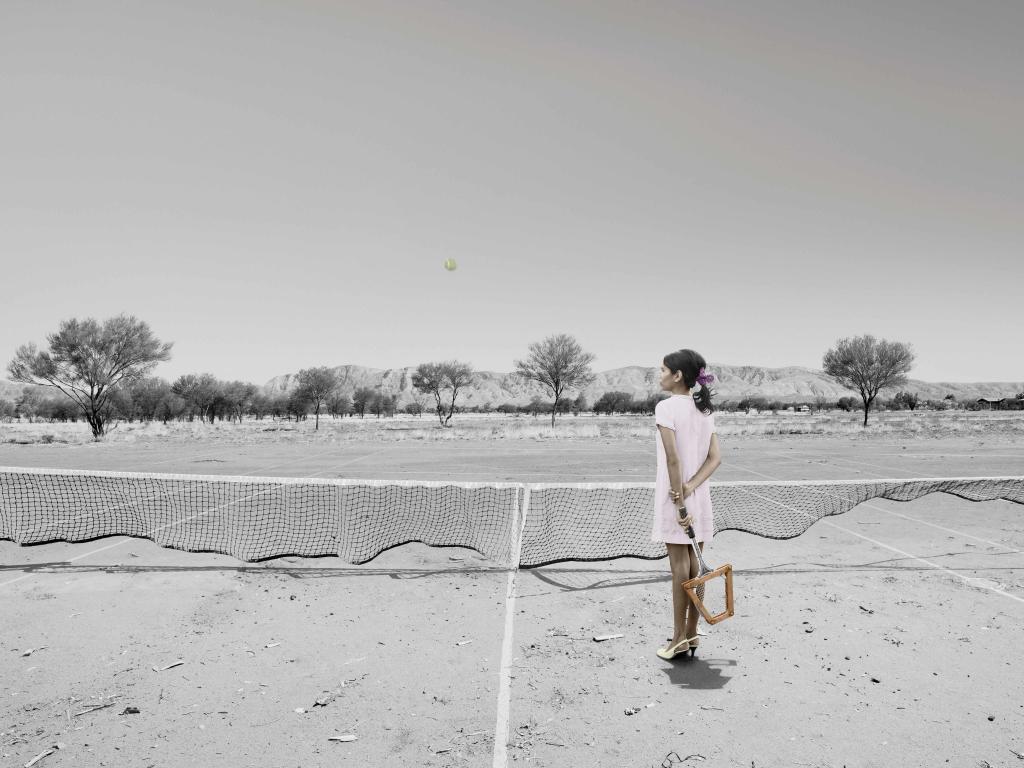Detail of Michael Cook’s winning work, Mother Tennis, 2016 Sunshine Coast Art Prize, digital photograph inkjet on photo rag; supplied courtesy the artist
There are well over 300 art prizes and awards offered in Australia annually, and metropolitan and regional galleries present the majority of those. It is a tough fight for visibility, especially when cast against the big brand prizes and the majors in the cities.
One thing that puts smaller galleries into the playing field is to increase the prize-money, and to flip their thinking to a national profile.
Last year the Sunshine Coast Art Prize increased its major prize to $25,000, in addition to an existing $5,000 highly commended award and $2,500 People’s Choice award, by securing a corporate sponsor, Audi Centre Sunshine Coast.
The number of entries almost doubled to a record 625. Considering that Australia’s most famous prize, the Archibald attracted 832 entrants that same year, the interest demonstrates competition in the regions can punch above their weight.
Curator at Caloundra Regional Gallery, and organiser of the prize, Hamish Sawyer told ArtsHub: ‘That extra money makes the prize competitive in a national sense.’
Topping the dollars off with a residency, this regional art prize has reinvented itself to have national currency – and the calibre of finalists is reflecting that change.
Exhibition opportunity
There are so few opportunities today for artists to show their work, especially as commercial galleries and the small to medium sector struggle with funding.
Sawyer said that regional prizes present a solid opportunity for artists to exhibit in a public space, and potentially enter a public collection. The Sunshine Coast Art Prize is an acquisitive prize, and eleven years of that accumulated collection will be exhibited at Caloundra Regional Gallery in April.
‘From a regional gallery perspective, the possibility to show and work with artists of the highest calibre, and with a national reach, may not be always available to us at more regional locations, but a prize sporting a fairly healthy pool of money puts us on the map.’
While Sawyer admits that the Sunshine Coast Art Prize is not the biggest prize in Queensland, Caloundra Regional Gallery has an incredible space with a very engaged audience, offering potential for greater impact than some competing awards.
Further sponsorship by International Art Services (IAS) means that the Gallery can cover the costs of return transport on artworks selected for the finalist exhibition. This frees up the artist a little, especially artists from out of state who are usually encumbered by freight costs.
‘This partnership enables us to include artists from across the country, and to showcase the best contemporary Australian art being made now. It just opens up our whole perspective,’ said Sawyer.
Caloundra Regional Gallery has ticked all the boxes and reinvented this prize to remain current. The Gallery also publishes a catalogue for the prize with reproductions and statements by each artist, which is a fantastic career tool that lasts well beyond the prize period.
Part of the award’s legacy is its alumni of winners, including Tony Albert (2007), Scott Redford (2008), David Fairbairn (2012), Celeste Chandler (2013) and Michael Cook (2016), adding to the award’s building prestige.
‘If you look at artists who are high profile, and look at their CVs, art prizes are always there on their way up. Someone like Tony Albert won the Sunshine Coast Art Prize at the start of his career trajectory. It does have an importance. It is really about getting your work out there – to be visible – and to have your work shown. It’s crazy to underestimate that value,’ said Sawyer.
For any up-and-coming emerging artist, or even mid-career artist, to have their work presented in that field of competition and considered seriously by a judge with a national profile is a professional boon.
This year, Angela Goddard, Director of Griffith Artworks, Griffith University (and formerly with the Queensland Art Gallery) has been confirmed as the judge of for 2017.
Choosing the right award for you
The pressure of making new work for a prize, on top of entry fees and shipping, can be a burden for an artist. Sunshine Coast Art Prize makes it easy. The guidelines are:
- A 2D artwork in any media, measuring up to 150 x 150cm
- The work must have been made within the last two years
- It must be framed, or ready to hang
- You have to be an Australian resident
- All you have to do is fill in the entry form and submit three images, one for prize consideration and two supporting images.
Sawyer says the number one rule for getting a look-in is good images.
‘Remember the pre-selection panel is working from what is being submitted, so make that image good both in terms of quality and also in terms of context. It is amazing how often the two back up images have no relation at all – it is as though they are made by a different artist,’ he said.
Over the 11 years of the prize to date, only two women have won. ‘We would love another female winner,’ said Sawyer. ‘A number of our judges have been female over the years. At the end of the day it’s down to the work on the wall.’
Sunshine Coast Art Prize 2017 finalists will be announced in May 2017 and will be showcased in an exhibition held at Caloundra Regional Gallery from 17 August – 8 October 2017.
The Sunshine Coast Art Prize 2017 is currently calling for entries. Get yours in before 31 March.





